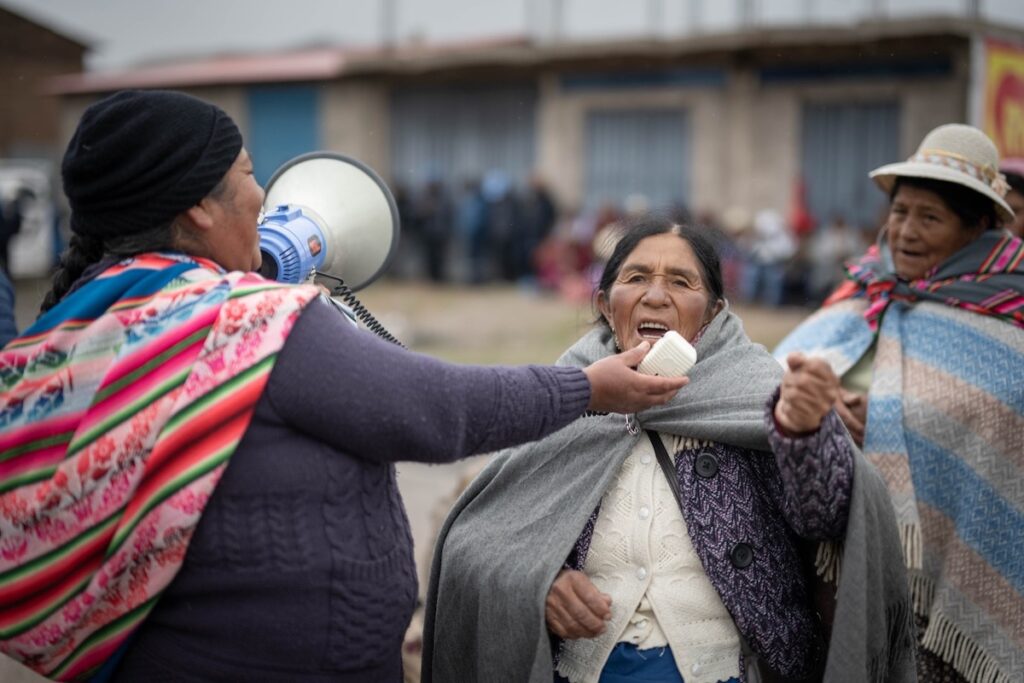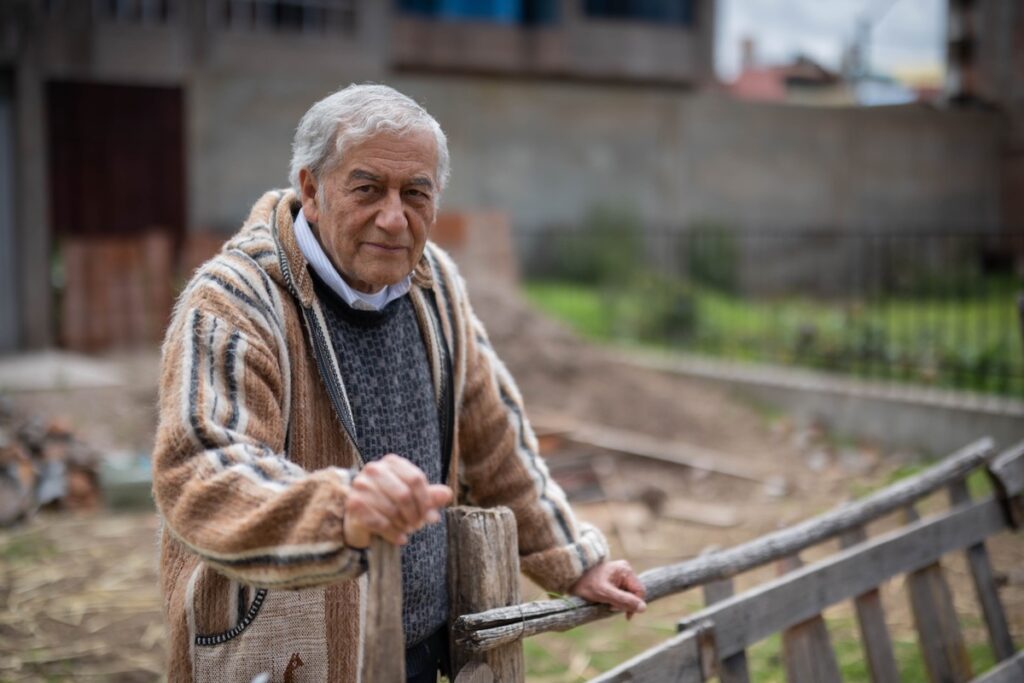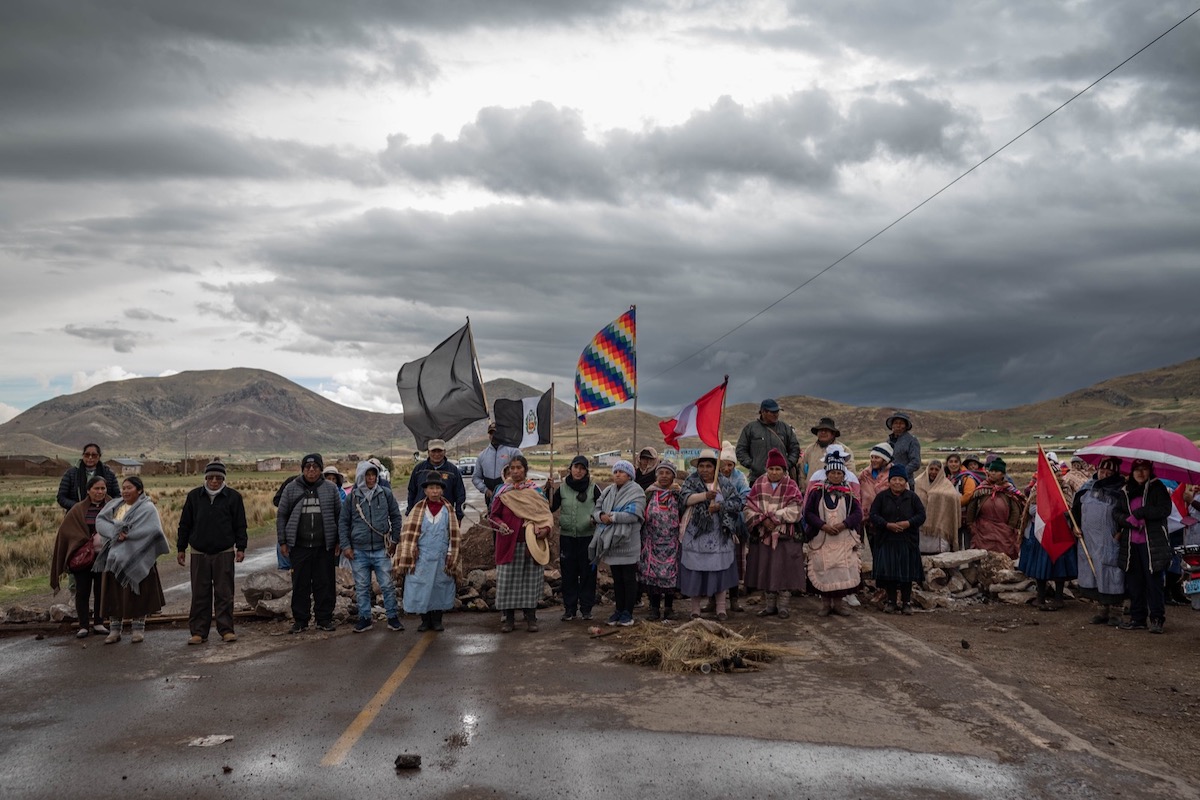(Above: A road block is set up — one of more than a dozen — along the highway connecting Cuzco and Juliaca by members of Perú’s Quechua community. Credit: Manuel Ortiz)
Leer este artículo en español
The “polycrisis” is an emerging term working its way into the parlance of lawmakers and global decisionmakers, from elite universities to the meeting rooms at Davos. The term is broad in its definition; almost amoeba like, it morphs to envelop the many challenges confronting humanity, from climate catastrophe to poverty, hunger, war, mass migration and the decline of democracy.
In early December, Perú erupted in protest after the Latin American nation’s former president, Pedro Castillo, attempted a takeover of the government. Since then, some 70 protestors have been killed, allegedly at the hands of local law enforcement. Protestors, many of them from Perú’s Indigenous communities, are demanding the resignation of the current president, Dina Boluarte, and a redrafting of the nation’s constitution. Boluarte, a former member of the Marxist Free Perú party, has turned to the right as she seeks to end the protests. Neither side appears willing to concede.
The divisions laid bare by the protests in Perú are fueled by some of the highest levels of inequality in one of the most unequal corners of the world, where mortality rates during Covid soared far above global averages and where sporadic economic growth and environmental degradation have long gone hand-in-hand. Perú has had six presidents in seven years and three different parliaments. A poll from 2021 found that barely a quarter of the country is satisfied with democratic rule, the lowest of any country in Latin America except Haiti.
It is, in short, a living embodiment of the polycrisis.
Photojournalist and founder of Peninsula 360 Press Manuel Ortiz has long experience covering conflict in Latin America, from cartel violence in Mexico to civil war in Colombia and social unrest in Honduras and El Salvador. He’s just returned from a 10-day reporting trip to Perú, a trip he describes as among “the most intense” in his long career. While conditions in Perú are unique to the country, the broader picture, says Ortiz, stands as a warning to the world of what happens when societal divisions are allowed to fester, when institutions fall short and when calamity rushes in to fill the breach.

You described your experience in Perú as among the most tragic of any you’ve encountered in Latin America. Why is that?
I’ve witnessed the government in Colombia systematically shooting out the eyes of young protestors. And I’ve seen a lot of violence in Mexico. But in Perú, it looks like a policy of extermination. They are using snipers… I saw them in Cuzco. I met with the family of Remo Candia Guevara, who was shot in the chest during a January 11 protest near the city. He was a local Quechua leader, someone everyone turned to, especially when this latest crisis erupted. Days before his death, he told his family he was being followed. They urged him not to join the protests, but he went anyway after community members told him he was needed. There is a video of him at the head of the crowd. No weapons… no stones, no sticks. The police fire tear gas. Remo tries to duck behind a post. It’s then that he is shot in the chest. He died in the hospital shortly after. His family told me the police targeted him. They knew who he was.

You attended a memorial marking one month since his death. What did you hear there from the community?
People were nervous at first. But as the memorial went on, they began to talk to us. They thanked us for being there, as members of the international press. They spoke of how journalists from (the capital) Lima never speak to or visit Quechua communities, which many Peruvians — we came to learn — often equate with terrorism. They feel as if they’ve been forgotten.
The next day we shared breakfast. I played with his kids, and they would ask me, “When is papi coming home.” Later we headed toward a nearby hilltop, where hundreds gathered to plant trees. It’s part of Quechua tradition, something they do every 10 years or so to reforest the surrounding mountains. But this year had an added layer of meaning. Many there told me they believe Remo will come to inhabit the trees and the mountain and that he would watch over them.

What did protestors tell you about their demands? What are they seeking?
Very few of them mentioned the former president, Pedro Castillo, who most of them voted for. Their main demand is the resignation of the current president. Some even told me that if she resigns today, the protests will end and that they can negotiate other issues. They feel betrayed by Boluarte, someone who came from the left but is now aligned with Perú’s right wing. They also feel the constitution does not represent them and they are demanding that it be reformed to be more reflective of Indigenous concerns.
What did you hear from ordinary Peruvians you met about this current crisis?
Peruvians are very divided. When we landed, I asked our Uber driver what he made of the situation. He called the protestors terrorists. I mentioned the protestors killed by police, and he said they deserved to die. He called them ignorant. I couldn’t believe it. I was shocked. I have never seen the kind of anti-Indigenous racism I encountered in Perú. But then you turn on the TV, and that’s what you see on the news — interspersed with ads from mining companies operating in Perú’s south, where most of the Indigenous communities live.
But we also met a taxi driver, a father from Cuzco who we hired to take us into the mountains. He’d grown up near Indigenous communities, but he had almost no contact with them. He showed tepid support for the protests, but he also had misgivings about the Indigenous protestors, saying they’d done “bad things.” We spent several days together, during which time he listened to the testimony of Quechua people whose loved ones had been killed in the protests. When we parted, he thanked us. “You showed me something of my country I had never known before.”

You also interviewed a local police chief during a protest in Cuzco. What was your impression of him?
He arrived at the main plaza in Cuzco where he addressed a gathering of Peruvian journalists. But it wasn’t an interview. There were no questions. He basically gave off a list of crimes committed by the protestors and assured the press that things were under control. I asked for an interview with him, and when I pressed him about the killing of protestors by police, he grew visibly angry. I don’t know if that is when we began to be followed — we were photographed several times during our trip — but many activists I spoke to here have told me they are being targeted.
More than 70 people have been killed since the protests started in December. Who are they and what have you heard from their friends or relatives?
The people who have died are mostly poor, many are young, some are children and some elders. Some of those killed were just caught in the crossfire walking by. We don’t have exact numbers of those killed or injured, partly because there have been reports of protestors being detained by police in local hospitals. So many are now afraid to seek medical treatment.


We met with a large group of victims’ relatives at the Pueblo de Dios church in Juliaca, in the south. We thought we’d be speaking to one or two people at most. But when residents learned we were there they began to flood the church. At one point it was near to full. They told us the media has not come, ever, to hear their stories. I am still getting calls from people there who could not make it to the church that day. The priest there is called Padre Lucho. He comes out of the Liberation Theology movement and has turned his church into a kind of community center, where the injured and grieving come, and where donations are sent to support local communities. Padre Lucho is compiling a list of the injured and killed. He is, in some ways, a bulwark against even more severe repression. I asked him at one point how he holds up and how it is that he seems to be constantly wearing a smile. He teared up then… “People like me, and I like people.”




